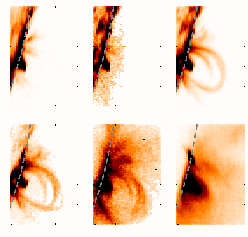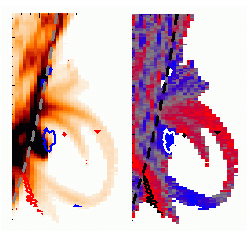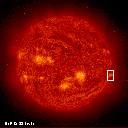Rapid Variations and High Speed Flows in Active Region Loops
|
Click on the images for full-size versions with annotations. |
|||

|

|
||
|
PostScript (720k);
PDF (65k) Movies: MPEG (1.3M), JavaScript (2.5MB) |
PostScript (1M);
PDF (50k) Movies: MPEG (900k), JavaScript (2.5MB) |
||
|
Left: Coronal Diagnostic Spectrometer (CDS) raster images showing
the intensity distribution in six emission lines observed
simultaneously. The movie shows about one fourth of an observation
series obtained during 39 hours of uninterrupted study of the active
region AR8737 on the south west limb in October 1999.
|

|
Right: The intensity and velocity of the O V 629 Å line
formed at 230 000 K derived from the same uninterrupted study of
AR8737. Pixels with Doppler shifts corresponding to a velocity
greater than ±40 km/s (144000 km/h or 90000 mph) are fully
red/blue. Contours outline areas with velocities exceeding
±50 km/s (180000 km/h; 112000 mph). The velocities are
calculated relative to the part of the solar disk that is within the
field of view.
|
|
| Center: The white box in the EIT 304Å image above shows the location of the CDS observations. | |||
Caption: Recent observations made with CDS demonstrate that the emission from plasma at transition region temperatures (100 000 K to 500 000 K) confined in magnetic loops above active regions, is changing rapidly with time, possibly owing to corresponding rapid changes in plasma temperature. Large Doppler shifts are frequently seen in these loops, but the highest velocities often occur outside the most intensely emitting structures.
The left figure demonstrates that the intensity distribution and temporal variability of the transition region lines and the He I 584 Å line, emitted in a much cooler plasma at 10 000 K, are quite similar. The emitting loops may change their shape completely or come and go on time scales as short as 10 minutes, the time it takes to record a raster. We also note that the coronal line Mg IX 368 Å shows nice loop structures that varies with time, but these loops are not as clearly defined or as variable as those appearing at lower temperatures.
In the right panel the velocity maps of the O V 629 Å line show a complicated velocity pattern. The regions with the largest Doppler shifts are often situated outside the most intense structures. Some loops have small velocities and other loops are redshifted in one leg and blueshifted in the other, as if the plasma is flowing up one leg and down the other, i.e. siphon flow. Typical velocities in the loops range from 0 km/s to ±30 km/s (108000 km/h; 67000 mph) relative to the disk. Outside the loops we find velocities close to -200 km/s in strongly blueshifted areas and exceeding +100 km/s in redshifted structures.
Data analysis and caption by Terje Fredvik (terje.fredvik@astro.uio.no) and Olav Kjeldseth-Moe (olav.kjeldseth-moe@astro.uio.no).
Instrument:
CDS (Coronal Diagnostic Spectroscope), EIT (Extreme ultraviolet Imaging
Telescope);
Taken:
October 26, 1999, 22:50 UT - October 27, 1999, 09:56 UT


